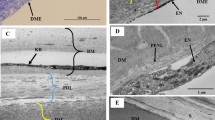Summary
Using a modified silver impregnation technique the endothelial lining of Schlemm's canal was studied in flat whole mounts. The inner and outer wall of the canal were prepared as membranes and the surfaces studied. The silver lines showed characteristic differences between the inner and outer walls of the canal. The cells of the inner wall are normally elongated and spindle-like, with an average length of 160 μm, which is half as long as those of the outer wall. In man their areas measured on the average 408 μm2 in the inner wall, and 792 μm2 in the outer wall. Thus, the intercellular border areas of the inner wall of Schlemm's canal are more extensive than those of the outer wall. In two species of monkeys (Cercopithecus aethiops, Macaca mulatta) similar histometric differences were detected, with the exception that the cells of the inner wall are smaller here (approx. 252 μm2) than those of the outer wall (approx. 796 μm2). Specific pores, stomata, or microchannels could not be found with the silver impregnation method.
The presence of a greater number of endothelial cells, and, thus, of the intercellular spaces, in the inner wall, may be of functional importance for the process of aqueous filtration.
The autolytic processes of the wall structure were also investigated in human eyes. In the outer wall autolytic changes occur as soon as after 9–13 hrs., whereas at the inner wall they can not be demonstrated before 18 hrs. Major structural changes, however, could be seen only after 42–50 hrs.
Zusammenfassung
Mit einer modifizierten Silberimprägnationstechnik wurde an Totalpräparaten das Endothelmuster des Schlemmschen Kanals im ganzen zur Darstellung gebracht. Innen- und Außenwand des Kanals wurden als Häutchen in toto präpariert und von der Fläche her untersucht. Die so gewonnenen Silberbilder zeigten charakteristische Unterschiede zwischen Innen- und Außenwand des Kanals. Die Innenwandzellen sind in der Regel langgestreckte, überwiegend äquatorial verlaufende, spindelförmige Zellen von durchschnittlich 160 μm Länge, die um etwa die Hälfte kleiner sind als die der Außenwand. Die Flächenausdehnung der Endothelzellen beträgt beim Menschen an der Innenwand durchschnittlich 408 μm2 und der Außenwand 792 μm2.
Bei zwei Affenarten (Cercopithecus aethiops, Macaca mulatta) fanden sich histometrisch ähnliche Unterschiede, nur sind hier die Innenwandzellen kleiner (durchschnittlich 252 μm2) als die der Außenwand (durchschnittlich 796 μm2). Dit intercellulären Grenzflächen der Innenwand des Schlemmschen Kanals sind damie zahlreicher als an der Außenwand. Spezifische Porenka oder Stomata konnten mit der Silbermethode nicht nachgewiesen werden. Die größere Zahl der Innenwandendothelien und damit der Intercellularspalten wird mit dem Filtrationsprozeß in Zusammenhang gebracht.
Am menschlichen Material werden auch die Autolysevorgänge beschrieben. Autolyseerscheinungen treten an der Außenwand bereits nach 9–13 Std auf, während sie an der Innenwand erst in stärkerem Ausmaß nach 42 Std nachzuweisen sind.
Similar content being viewed by others
Literatur
Ashton, N., Brini, A., Smith, R.: Anatomical studies of the trabecular meshwork. Brit. J. Ophthal. 40, 257–282 (1956).
Bill, A.: Persönliche Mitteilung.
Castenholz, A.: Vitalmikroskopische, histologische und elektronenmikroskopische Untersuchungen zur funktionellen Morphologie der Endstrombahn. Habil.-Schrift, Marburg a. d. Lahn 1969; Verhandlungen der Mainzer-Akad. d. Wissenschaften. Wiesbaden: F. Steiner 1970 (im Druck).
Florey, H. W., Poole, J. C., Meek, G. A.: Endothelial cells and “cement” lines. J. Pathol. a. Bact. 77, 625–636 (1959).
Garron, L. K., Feeney, M. L., Hogan, M. J., McEwen, W. K.: Electron microscopic studies of the human eye. Preliminary investigations of the trabeculas. Amer. J. Ophthal. 46, part II, 27–35 (1958).
Gottlob, R., Hoff, H. F.: A study of the relation between endothelial silver lines, media transversal silver lines and the ultra structural morphology of blood vessels. Vasc. Surg. 1, 92–100 (1967).
— —: Histochemical investigations of the nature of large blood vessel endothelial and medial argyrophilic lines and on the mechanism. of silver staining. Histochemie 13, 70–83 (1968).
—, Zinner, G.: Die Bestimmung der endothelschädigenden Wirkung injizierbarer Lösungen. Der Einfluß des osmotischen Druckes und des pH. Wien. klin. Wschr. 9, 149–157 (1965).
Holmberg, A. S.: Schlemm's canal and the trabecular meshwork. An electron microscopic study of the normal structure in man and monkey (Cercopithecus ethiops). Docum. ophthal. (Den Haag) 19, 339–373 (1965).
Kayes, J.: Pore structure of the inner wall of Schlemm's canal. Invest. Ophthal. 6, 381–394 (1967).
Rohen, J. W.: Das Auge und seine Hilfsorgane. Handbuch der mikroskopischen Anatomie des Menschen. Berlin-Göttingen-Heidelberg-New York: Springer 1964.
—, Castenholz, A.: Morphologische Grundlagen der Zirkulation und Permeabilität im Bereich der Endstrombahn. Neue Aspekte der Trasylol-Therapie, Bd. 3, S. 1–19. Stuttgart-New York: Schattauer 1969.
—, Rentsch, F. J.: Elektronenmikroskopische Untersuchungen über den Bau der Außenwand des Schlemmschen Kanals unter besonderer Berücksichtigung der Abflußkanäle und der Altersveränderungen. Albrecht Graefes Arch. klin. exp. Ophthal. 177, 1–17 (1966).
Sinapius, D.: Über das Endothel der Venen. Z. Zellforsch. 47, 560–630 (1958).
—: Über die Grundlagen und Bedeutung der Versilberung und verwandter Methoden nach Untersuchungen am Aortenendothel. Z. Zellforsch. 44, 27–56 (1956).
Speakman, J. S.: Drainage channels in the trabecular wall of Schlemm's canal. Brit. J. Ophthal. 44, No 9, 513–523 (1960).
—: Aqueous outflow channels in the trabecular meshwork in man. Brit. J. Ophthal. 43, No 3, 129–138 (1959).
Spencer, W. H., Alvarado, J., Hayes, Th. L.: Scanning electron microscopy of human ocular tissues: Trabecular meshwork. Invest. Ophthal. 7, 651–662 (1968).
Subbotin, H. Ja.: Über die Zellgrenzen des Meso- und Endothels. Dokl. Akad. Nauk SSSR, N. S. 86, 1159–1160 (1952).
Tripathi, R. C.: Ultrastructure of Schlemm's canal in relation to aqueous utflow. Exp. Eye Res. 7, 335–341 (1968).
Author information
Authors and Affiliations
Rights and permissions
About this article
Cite this article
Lütjen-Drecoll, E., Rohen, J.W. Über die endotheliale Auskleidung des Schlemmschen Kanals im Silberimprägnationsbild. Albrecht von Graefes Arch. Klin. Ophthalmol. 180, 249–266 (1970). https://doi.org/10.1007/BF00414733
Received:
Issue Date:
DOI: https://doi.org/10.1007/BF00414733




